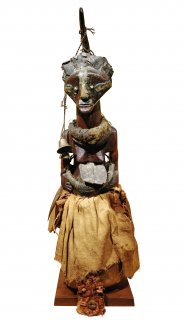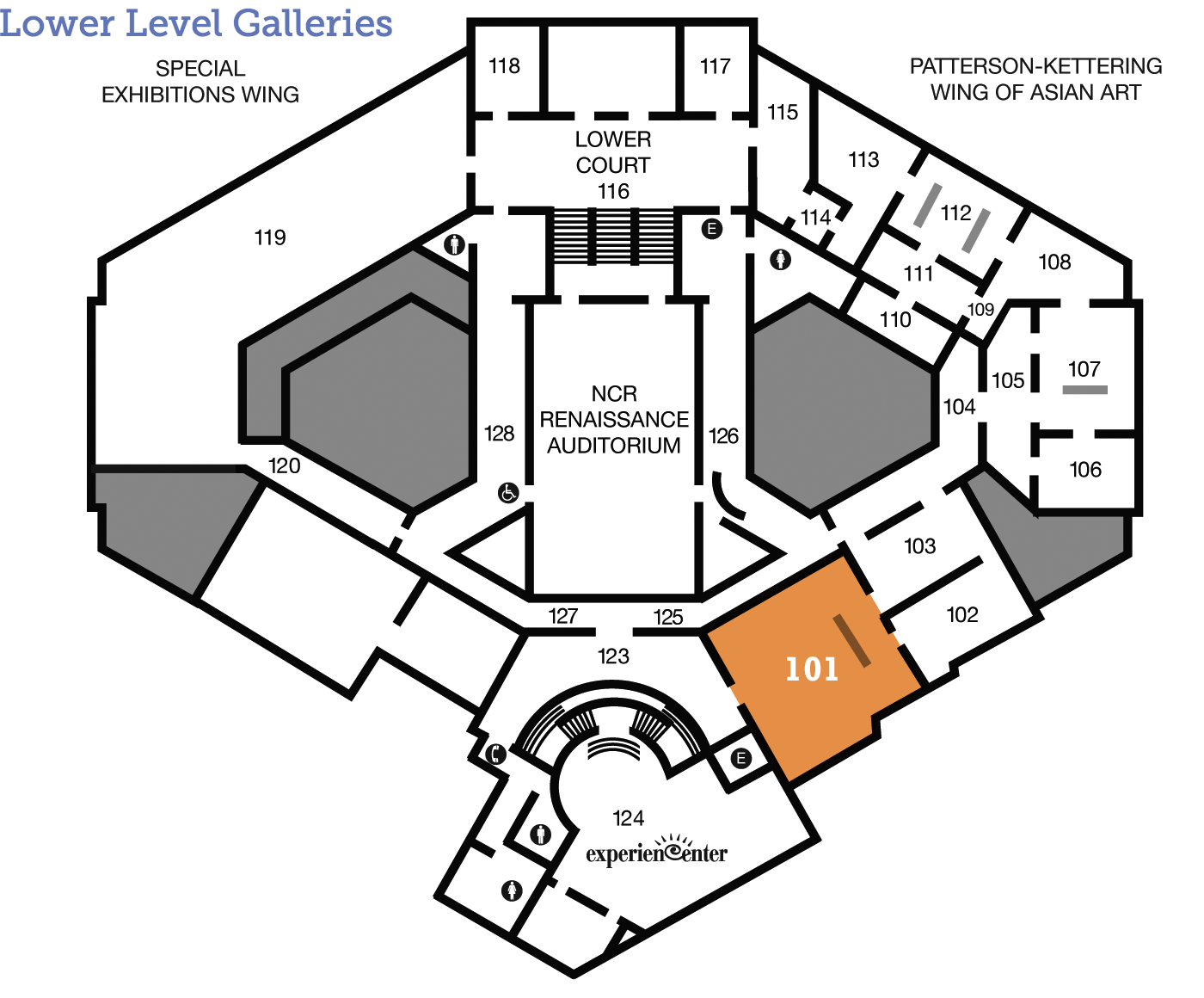
Songye people
Nkishi (Power Figure)
Hard wood, metal, antelope horns, civet hide, lizard skin, fiber, feathers, nuts, oil, and fiber cord Height: 46 inches Gift of Dianne Komminsk in memory of Dr. Roy Sieber 2001.61
Powerful
Do you have any statues in your community? Can they protect you from danger? This figure, called a nkishi, does more than just stand around. Find out how it was art in action for the Songye people of the Democratic Republic of Congo.
A Day in the Life
Public and Private
There are two kinds of nkishi, small ones for personal use, and large ones for the community. This large nkishi is an example of a community figure. If you are in the galleries, you can see examples of personal nkishi in the case nearby. Personal nkishi are smaller and often serve a temporary purpose, such as overcoming an illness or infertility, after which they may be deactivated and discarded. Community figures are larger, carved and activated by respected experts, and put in a special place where they may be kept for a long time. What is the life of a community nkishi like? Learn more in the following audio clip, which includes commentary from Niangi Batulukisi, Assistant Curator of African Art at The DAI in 2001.
Transcript:
This large wooden figure was for many years the ritualistic protector of a Songye village in the southeastern Congo. Carved in the late 19th century, the sculpture itself would have been powerless without the magical elements affixed to it by the diviner or ritual specialist known as the nganga. Embedded in the horn and the large head and abdomen might be roots, animal claws and teeth, clay from the river, each a substance representing the power of the mineral, vegetable, and animal realms, and symbolic of survival and strength.
In the hands of the nganga, a sculpture may become a power figure, called an nkishi. Assistant curator Niangi Batulukisi talks about the role of the nkishi in a community. “This object is used for the purpose of the community. It’s stored in a special house near the chief’s house. The chief is the one who should keep this object and who takes care of this figure. When there is a problem in the village the chief will organize a ceremony where these objects will be the center of the ritual. The nganga is the only one who can activate this figure, and nobody can take or touch this figure except the nganga.”
Once the nganga has activated the figure, a guardian, who can be a man or a woman, is chosen by the village. The guardian, together with the chief, is responsible for the care of the nkishi. After the guardian tells the nganga what has been revealed from the spirit or dream world, the nganga prescribes a course of action to remedy the problem. It is the guardian’s job to follow the instructions of the nganga in order to ensure the efficacy of the nkishi.
Further reading: Dunja Hersak, “Visible and Invisible Features of a Songye Figure,” in Fragments of the Invisible: The René and Odette Delenne Collection of Congo Sculpture (Cleveland: The Cleveland Museum of Art, 2013), 64–67.
Tools and Techniques
Behind the Scenes
More than Meets the Eye
Advances in technology provide museums with new, non-invasive tools for better understanding objects. For example, institutions such as the Indianapolis Museum of Art and the Cleveland Museum of Art have used CT scans to observe the internal structure of Songye nkishi figures. They have confirmed the presence of internal cavities that connect to the mouth and other openings. In fact, part of the community’s care of a nkishi may involve giving it food and drink. Below you can see an image of a CT scan of a Songye figure from the Cleveland Museum of Art. (For more information on this object click here.)
Researchers at Cleveland also used x-ray fluorescence spectrometry (XRF), which identifies the basic composition of the different materials on and in the figure. For example, they found the ritual material (bishimba) inserted in the stomach is high in calcium and iron.
These examinations shed light on how The DAI’s nkishi may look inside, for it has never been studied with these technologies. This means there are more things to discover in the future.
Further reading: Colleen Snyder and Samantha Springer, “Inside Out: Materials Identification and CT Imaging of a Songye Figure,” in Fragments of the Invisible: The René and Odette Delenne Collection of Congo Sculpture (Cleveland: The Cleveland Museum of Art, 2013), 68–73.
Look Closer
Just for Kids
Imagine!
This large, wooden nkishi was used by the Songye people during special ceremonies. Nikishi are power figures that protected the safety and health of the community. If your neighbors decided to place a sculpture in the middle of your neighborhood, what might this sculpture look like?
Signs & Symbols
Animal Strength
Various natural and human-made items are placed on this nkishi, giving it power. The most important is the ritual substance, or bishimba, which activates the figure (see “A Day in the Life” and “About the Artist”). Pieces of different animals are also attached, which associates the figure with the strength of those animals. Look closer at the figure and see how many different animal materials you can find on it. Do you know what they are? Tap the points to find out more.
Dig Deeper
Arts Intersected
The Sculpture Speaks
Did You Know?
Handle with Care
Once an nkishi is activated by an nganga, or ritual specialist (see “About the Artist”), nobody may touch the figure except the nganga. In order to move the figure, then, special poles are used. The poles used with this nkishi are not on display, but you can see a picture of them below. Look closer under the arms of this figure and notice areas that have been worn smooth, indicating the extensive use of it over time.
Expert Opinion
Look Around
About the Artist
A Real Action Figure
A nkishi is not made just to be looked at and admired, like other sculpture. In comparison to Western art, the sculptor is not even the most important person involved in creating a nkishi. The DAI asked Dr. Frank Eguaroje, Professor of African Anthropology at Wright State University, about this work. Tap on the questions to learn more about how it was made and used.
Who creates a nkishi?
Two individuals are crucial to the making and employing of an nkishi: the carver, and the ritual specialist or nganga, who is an expert in medicines and ritual power. Mankishi (plural of nkishi) are powered by potentially lethal spirits; thus the process of making these sculptures was deemed dangerous. When an element was inserted, it activated the figure and determined if the figure’s purpose would be protective or aggressive.
How is a nkishi used?
The aims and functions of an nkishi vary from political to social and spiritual concerns. The most common functions include ending a dispute, making an agreement permanent, healing, overpowering an enemy, or protection. As objects of personal battle, nkishi often incorporate military attire such as headdresses, thick iron chains, and bells.
Talk Back
Changing Places
This nkishi figure was originally made to be used in a Songye community. Today it is seen halfway around the world in The DAI. What may an object lose by being taken out of its original context? On the other hand, what might an object gain by being relocated to a museum environment? Is there such as thing as a “right” place for an object?

